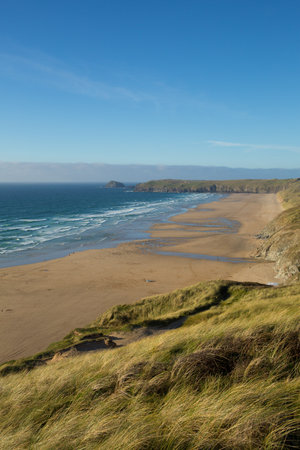Introduction to Dog-Friendly Beaches in the UK
The United Kingdom has witnessed a notable rise in the popularity of dog-friendly beaches, with England, Scotland, and Wales leading the way. More pet owners are now seeking scenic coastal spots where their canine companions can run, swim, and play freely. This shift reflects a broader cultural trend: dogs are increasingly seen as part of the family and welcomed in public spaces across the UK. From Cornwall’s golden stretches to the rugged Scottish coastline and the hidden gems of Wales, local councils and communities have responded by making more beaches accessible for dogs year-round or during specific months. The table below highlights some key attitudes and policies towards dogs on beaches across these regions:
| Region | Cultural Attitude | Common Beach Policies |
|---|---|---|
| England | Welcoming, especially outside peak summer | Seasonal restrictions common; many off-lead areas |
| Scotland | Generally relaxed; strong outdoor culture | Fewer restrictions; emphasis on responsible ownership |
| Wales | Friendly and inclusive, especially in rural areas | Mix of seasonal bans and year-round access |
This evolving approach not only benefits dog owners but also supports local tourism, as more Britons opt for staycations with their pets. Before visiting, however, it’s important to be aware of local rules regarding leads, waste disposal, and designated dog-free zones—topics we’ll explore in detail throughout this guide.
Top Dog-Friendly Beaches in England
If youre planning a seaside adventure with your furry friend, England boasts a fantastic selection of dog-friendly beaches. From the sprawling sands of Cornwall to the rugged coastline of Northumberland, there’s something for every canine and their owner. Below, we’ve highlighted some of the best dog-welcoming beaches in England, including details about local amenities and important information on seasonal restrictions you’ll want to know before you go.
Cornwall: Perranporth Beach
Perranporth is renowned among dog owners for its vast golden sands and welcoming attitude towards pups. Dogs are allowed all year round, although they must be kept on leads during July and August between 10am and 5pm. There’s a beachside café where dogs are welcome, plus plenty of nearby walking trails.
Northumberland: Bamburgh Beach
Bamburgh offers miles of open sand perfect for energetic dogs. There are no seasonal restrictions here, making it an excellent choice whatever the time of year. The village itself is charming, with several pet-friendly pubs and accommodation options available.
Devon: Saunton Sands
Saunton Sands is another top pick, especially as dogs can roam freely across its three-mile stretch throughout the year. Dog waste bins are provided and the nearby car park makes access easy. Local cafés often have water bowls outside for thirsty pups.
Dog-Friendly Beaches at a Glance
| Beach | Location | Dogs Allowed? | Seasonal Restrictions | Amenities |
|---|---|---|---|---|
| Perranporth Beach | Cornwall | Yes | On lead 10am-5pm (Jul-Aug) | Café, toilets, parking |
| Bamburgh Beach | Northumberland | Yes | No restrictions | Pubs, parking, shops nearby |
| Saunton Sands | Devon | Yes | No restrictions | Café, bins, parking |
| Sandsend Beach | Yorkshire | Yes | No dogs May-Sept (main area) | Café, toilets, walking paths |
| Camber Sands | East Sussex | Yes | Zoned areas May-Sept | Cafés, dunes, parking |
Tips for Visiting Dog-Friendly Beaches in England:
- Always check local signage for up-to-date restrictions.
- Bring fresh water and shade for your dog during warmer months.
- Dispose of waste responsibly—most beaches provide bins.
Selecting the right beach means happier dogs and stress-free days out. Whether you prefer lively resorts or secluded stretches, England’s coastlines have plenty to offer for both two-legged and four-legged visitors alike.

3. Scotland’s Best Sandy Spots for Dogs
Scotland is renowned for its rugged coastline and spectacular sandy stretches, many of which are perfect for dog owners seeking adventure with their four-legged companions. From the Highlands to the Borders, Scottish beaches offer a blend of breath-taking scenery and welcoming attitudes towards dogs.
Top Dog-Friendly Beaches in Scotland
| Beach Name | Region | Lead Policy | Nearby Facilities |
|---|---|---|---|
| Luskentyre Sands | Isle of Harris, Outer Hebrides | No restrictions; leads advised near livestock | Car park, bins, remote location (bring essentials) |
| West Sands Beach | St Andrews, Fife | Dogs allowed year-round; leads in nesting season | Cafés, toilets, parking nearby |
| Yellowcraig Beach | East Lothian | No restrictions but clean up after your dog is mandatory | Paved paths, picnic areas, dog bins available |
| Balcary Bay | Dumfries & Galloway | No seasonal bans; keep under control due to wildlife | Limited facilities; pack water and waste bags |
| Nairn Beach | Moray Firth, Highland | No restrictions but avoid dunes during bird nesting times | Café, toilets, easy parking access |
Regional Customs and Practical Tips
- Respect Local Wildlife: Many Scottish beaches are home to ground-nesting birds or grazing sheep. Keep dogs on a lead when signposted and always under control.
- Tide Awareness: Check tide times before you visit—some beaches almost disappear at high tide.
- Litter and Waste: Scotland takes pride in its clean landscapes. Always bag and bin dog waste. Some rural locations have limited bins, so bring spare bags and take waste home if needed.
Leash Laws and Restrictions Explained
Most Scottish beaches welcome dogs all year round with very few restrictions compared to some areas in England and Wales. However, local by-laws may apply during sensitive wildlife seasons. Always check signage at beach entrances and respect requests from local rangers or residents.
Packing Checklist for Scottish Beach Adventures with Dogs:
- Poo bags (and a backup supply!)
- Water and portable bowl—many remote beaches lack fresh water sources.
- Towel for drying off after a swim or rain shower.
- A long lead for recall practice in open spaces.
Exploring Scotland’s dog-friendly beaches is an experience rich in natural beauty and warm local hospitality. With a little preparation and respect for regional customs, you and your dog can enjoy safe, memorable outings along some of the UK’s most stunning coastlines.
4. Welsh Coastal Walks and Dog-Friendly Sands
Wales boasts some of the UK’s most breathtaking coastline, renowned for its scenic trails and welcoming attitude towards canine companions. Exploring the Welsh coast with your dog is a treat, thanks to miles of accessible walking routes and sandy beaches where dogs are embraced as part of the family.
Notable Dog-Friendly Beaches in Wales
| Beach Name | Location | Dog Restrictions | Walking Trails Nearby |
|---|---|---|---|
| Rhossili Bay | Swansea, Gower Peninsula | No restrictions year-round | Worm’s Head walk, cliff-top coastal path |
| Newgale Beach | Pembrokeshire | No restrictions from October to April; partial summer zones | Pembrokeshire Coast Path, local nature reserves |
| Barmouth Beach | Gwynedd, North Wales | Dog-free zone May–September (central area); open at either end all year | Mawddach Trail, estuary walks |
| Llansteffan Beach | Carmarthenshire | No restrictions year-round | Carmarthen Bay walks, castle ruins trail |
| Harlech Beach | Snowdonia National Park area | No restrictions outside main bathing area May–September; otherwise dog-friendly all year on northern end | Dunes trails, Harlech Castle walk |
Walking Trails and Accessibility Tips
The Wales Coast Path stretches for 870 miles, offering a wealth of options for every level of walker. Many sections are flat and suitable for prams or mobility aids, particularly around Cardigan Bay and parts of Pembrokeshire. Always check local signage for up-to-date information on accessibility and seasonal dog regulations.
Welsh Dog-Walking Etiquette: What to Know Before You Go
- Lead Up in Villages: Keep dogs on leads when passing through villages or near livestock.
- Bag It and Bin It: Always clean up after your dog—bins are provided at most car parks and beach entrances.
- Respect Wildlife: Protect local habitats by sticking to marked paths and preventing dogs from disturbing nesting birds or seals.
- Tide Awareness: Coastal walks may be affected by tides—check timings to avoid getting cut off.
- Café Culture: Many Welsh beach cafés offer water bowls and even treats for four-legged visitors.
Your Practical Checklist for a Day Out on the Welsh Coast:
- Packed waste bags and spare leads.
- A collapsible water bowl and fresh water supply.
- A towel for sandy paws after your walk.
- A map or app with tide times and walking routes.
- An ID tag with up-to-date contact details on your dog’s collar.
If you’re seeking dramatic cliffs, wide-open sands, or peaceful dunes, Wales delivers it all—with a warm “croeso” (welcome) to your canine companion at every turn.
5. Essential Tips for Visiting with Your Dog
Exploring the dog-friendly beaches of England, Scotland, and Wales is a fantastic way to bond with your four-legged friend, but it’s crucial to follow local etiquette and rules to ensure a positive experience for everyone. Here’s some practical advice every British dog owner should keep in mind.
Leash Rules: Know Before You Go
Different beaches have varying regulations regarding dogs on leads. Some require leads at all times, especially during peak seasons or in wildlife-sensitive areas, while others allow off-lead fun outside restricted months. Always check local signage or council websites before your visit. Below is a quick overview:
Beach Type |
Lead Requirement |
Typical Restrictions |
|---|---|---|
| Main/Urban Beaches | Often on-lead or restricted during summer (May-September) | Dog bans may apply; check notices |
| Rural/Natural Beaches | Usually more relaxed; off-lead permitted if under control | Watch for seasonal wildlife nesting zones |
| Protected Areas (e.g., nature reserves) | On-lead required year-round | Strictly enforced to protect wildlife |
Clean Up After Your Dog: It’s the Law
No matter where you are in the UK, it’s a legal requirement to pick up after your dog. Always carry plenty of poo bags and dispose of waste in designated bins. If none are available, take it home with you—leaving dog mess is not only anti-social but can result in hefty fines from local authorities.
Respecting Local Wildlife and Other Beachgoers
The British coastline is home to sensitive habitats and diverse wildlife, from ground-nesting birds in Wales to seal colonies in Scotland. Keep your dog under close control, especially near dunes and marked conservation areas. Avoid letting dogs chase birds or disturb resting animals. Also, be considerate of families and other visitors; not everyone is comfortable around dogs.
Packing Essentials for a Beach Day Out
- Lead and harness (plus a spare)
- Poo bags and hand sanitiser
- Fresh water and a travel bowl
- Towel for drying off sandy paws
- Sunscreen for sensitive noses (yes, dogs can get sunburnt too!)
- ID tag with up-to-date contact details – a legal must in the UK
Quick Checklist: Before You Set Off
- Check beach rules online or via council sites
- Pack all doggy essentials listed above
- Plan your visit outside busy periods if possible for a quieter experience
- Be prepared to adapt – weather and tides change quickly around Britain’s coast!
6. Resources and Local Regulations
Before setting off to explore the UK’s dog-friendly beaches, it’s essential to stay informed about local regulations and seasonal dog bans. Rules can vary not just from country to country, but even between neighbouring beaches within a single county. To help you plan your coastal adventures responsibly, here’s how to find reliable information and useful resources specifically for England, Scotland, and Wales.
Where to Find Up-to-Date Information
The best way to avoid disappointment is by checking official sources before you travel. Most local councils provide detailed guidance on their websites regarding which beaches allow dogs and any restrictions in place, particularly during peak holiday months. Many beaches implement dog bans or require leads between 1 May and 30 September, so always confirm the latest information.
| Country | Key Resource | Type of Information |
|---|---|---|
| England | The Beach Guide | Dog-friendly beach lists, council links, seasonal bans |
| Scotland | VisitScotland | Pet-friendly beach guides, visitor tips, rules per region |
| Wales | Visit Wales | Dog bans by location, best times to visit with dogs |
Council Rules and Bans: What to Watch For
- Look for signs at beach entrances detailing if dogs are allowed off-lead or must be kept on-lead.
- Check for ‘Public Spaces Protection Orders’ (PSPOs), which may impose fines if breached.
- Certain Blue Flag beaches have stricter rules—always check before arrival.
Useful UK-Based Dog-Friendly Travel Resources
- DogFriendly.co.uk: Accommodation, beaches, pubs, and attractions across the UK.
- The National Trust (Dog-Friendly Days Out): Lists properties and coastal paths open to dogs.
Quick Tips for Responsible Visits
- Always pick up after your dog – many councils have dedicated bins for waste disposal.
- If unsure about regulations, ask a local or consult the nearest tourist information centre.
By using these resources and respecting local rules, you’ll ensure every trip to England, Scotland, or Wales’s beautiful beaches is safe, enjoyable, and stress-free for both you and your four-legged friend.


